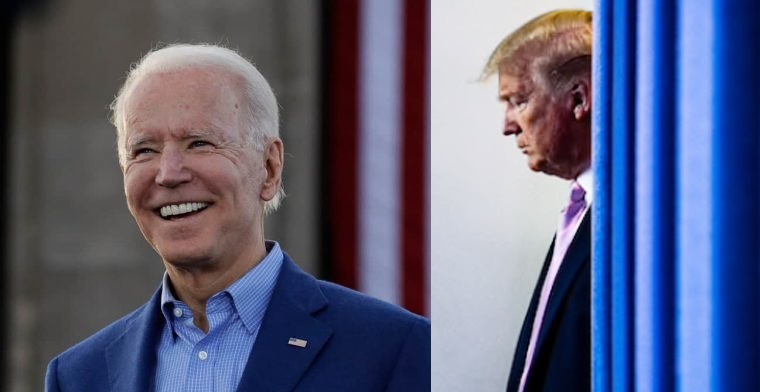Fearing a coming cash crunch, President Trump’s campaign has pulled back from television advertising over the last month, ceding to Democratic nominee Joe Biden a huge advantage in key states and sparking disagreements over strategy within the president’s senior team.
Republicans close to Trump have been baffled at the decision to sharply curb advertising and have told the president he should change course.
The complaints have upended the dynamics that dominated much of the race so far.
With less than eight weeks before Election Day, the once-lean Biden campaign is flush with cash, while the massive Trump operation is facing tough budgetary decisions down the stretch that have increased tensions around the president.
Among those worried is Republican National Committee Chair Ronna McDaniel, who recently told the president she was concerned his ads were not on television in states such as Michigan and Florida where Biden was blanketing the airwaves.
The decision to slash spending has been ordered by Trump’s new campaign manager, Bill Stepien, who has been restructuring the budget since taking over the campaign operation in July, after it had already spent nearly $1 billion.
Stepien has told others that cutting the ad budget was necessary because it was impossible to cut other spending, such as staffing or a campaign headquarters.
He has described facing difficult choices, as he tries to save considerable money for the final 30 days before the Nov. 3 election.
The moves have resulted in an enormous short-term advertising benefit for Biden, who maintains a polling lead in most of the battleground states.
Between Aug. 10 and Sept. 7, Biden’s campaign spent about $90 million on television ads, more than four times the $18 million spent by the Trump campaign, according to tracking by a Democratic firm.
Trump-aligned outside groups made up some of the difference, spending an additional $28 million, compared with about $16 million by groups backing Biden.
But the outside spending did not eliminate the Democratic advantages in competitive states.
Even with the outside group spending, Democrats have been able to dominate the airwaves where the election will probably be decided.
Between Aug. 10 and Sept. 7, pro-Biden efforts outspent pro-Trump efforts by a margin of $9.3 million to $560,000 in Michigan, $17.7 million to $6.1 million in Pennsylvania and $20.5 million to $7.8 million in Florida.
Meanwhile, Democrats are amassing an enormous lead in early voting, alarming Republicans who worry they’ll need to orchestrate a huge Election Day turnout during a deadly coronavirus outbreak to answer the surge.
The Democratic dominance spreads across an array of battleground states, according to absentee ballot request data compiled by state election authorities and analyzed by Democratic and Republican data experts.
In North Carolina and Pennsylvania, Democrats have a roughly three-to-one advantage over Republicans in absentee ballot requests.
In Florida — a must-win for Trump — the Democratic lead stands at more than 700,000 ballot requests, while the party also leads in New Hampshire, Ohio and Iowa.
Even more concerning for Republicans, Democrats who didn’t vote in 2016 are requesting 2020 ballots at higher rates than their GOP counterparts.
The most striking example is Pennsylvania, where nearly 175,000 Democrats who sat out the last race have requested ballots, more than double the number of Republicans, according to an analysis of voter rolls by the Democratic firm TargetSmart.
Though the figures are preliminary, they provide a window into Democratic enthusiasm ahead of the election and offer a warning for Republicans.
While Democrats stockpile votes and bring in new supporters, Trump’s campaign is relying on a smooth Election Day turnout operation at a time when it’s confronting an out-of-control pandemic and a mounting cash crunch.
Republicans acknowledge Democrats have established a lead, though some stressed it was early and compared it to a basketball team winning the opening tip-off.
Trump aides argue that the Democratic advantage will make little difference in the end, saying the opposing party is merely frontloading voters who otherwise would have voted on Nov. 3.
But the data also shows that Democrats are attracting new supporters in small but potentially significant numbers in states they narrowly lost in 2016.
In Pennsylvania, which Trump won by just 44,000 votes four years ago, Democrats have built a lead of nearly 100,000 ballot requests from voters who didn’t participate in the 2016 election but are preparing to vote by mail this year, according to TargetSmart’s figures.
In Michigan, where Trump won by fewer than 11,000 votes (and where voters do not register by party), the firm’s model shows that Democratic-aligned voters have a nearly 20,000-person advantage among non-2016 voters signing up to receive ballots.
In Wisconsin, which Trump won by 22,000 votes, Democratic-leaning voters who skipped 2016 have made nearly 10,000 more requests for this election than their GOP counterparts.
Democrats, who were widely criticized for running a lackluster turnout operation four years ago, say they are capitalizing on a wave of anti-Trump energy to bank ballots.
The party used its convention to press early voting, with prominent figures like former first lady Michelle Obama imploring people to cast ballots as soon as possible.
They point to Florida as a major bright spot. Democrats lead Republicans in vote-by-mail requests 2.1 million to 1.4 million, according to a GOP consultant who is tracking the figures.
At this same point in 2016, Democrats trailed Republicans in requests.
“While Trump is busy kneecapping Republican efforts to sign up his supporters to vote by mail with debunked claims about absentee voting, Democrats have a massive grassroots army focused on turning out voters early and on Election Day, and we’re already seeing strong results and real energy — including among first time voters,” said Michael Gwin, a Biden campaign spokesperson.
